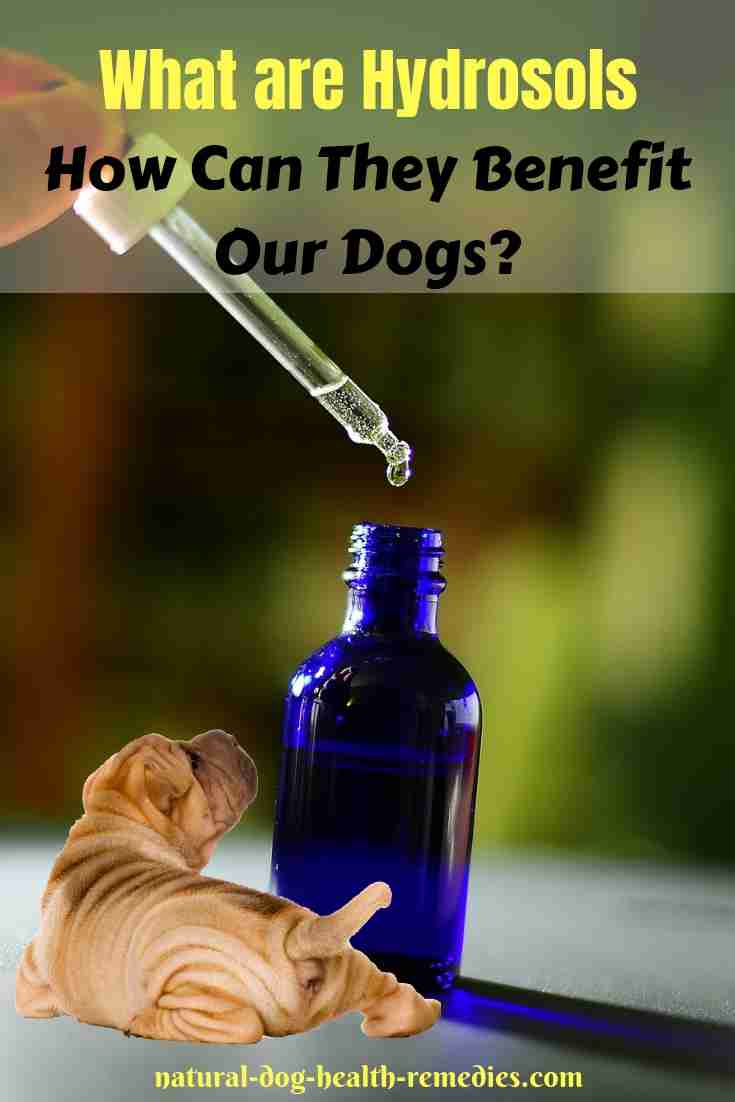Hydrosols for Dogs

Overview
If you like to use essential oils on your dog, you should also definitely try using hydrosols.
Hydrosols are sort of "new kids on the block". They are just starting to gain popularity and attention from people. But I am sure they will become more popular because they are very versatile.
Hydrosols can be used in different ways, both externally and internally, for numerous health issues.
This page focuses on hydrosols for dogs, and looks at the following:
- What are Hydrosols?
- How are They Different from Essential Oils?
- Some Uses of Hydrosols on Dogs
- Safety and Precautions
What Are Hydrosols And What Are Not
The word hydrosol comes from hydro (water) and sol (solution). It is produced as a result of the steam distillation process that makes the essential oils used in aromatherapy.
Hydrosols are not just distilled water with a few drops of essential oils added. Nor are they water mixed with some synthetic fragrance.
When producing essential oils, plant material is put in a large container, the bottom of which is filled with water. When the water is heated, the steam rises through the plant material, causing the plant material to burst and release its essence and oils into the steam.
As the steam rises to the top of the container, it carries the essential oils with it, which are then collected in a separate vessel. The remaining fragrant water that was steamed with the original plant material is the hydrosol.
While most hydrosols are usually made as a by-product in the process of essential oil production, some high-quality hydrosols are specifically produced just for the aromatic water.
How Are Hydrosols Different From Essential Oils?
Hydrosols are much milder and diluted than essential oils, and are therefore more suitable to be used on small pets (e.g. small dogs, cats) and those who do not seem to be able to accept the aroma scents of essential oils.
Hydrosols are also chemically different from their corresponding essential oils, and while some hydrosols smell similar to their corresponding essential oils, others are very different.
Hydrosols are also cheaper than essential oils, making them a good alternative of the latter if you want to spend just the minimum to test out if aromatherapy is the right thing for your dog!

Why Are Hydrosols Therapeutic?
Clinically, the chemical components in the hydrosol are primarily acidic; therefore, they acidify the water they are in. Hydrosols have a pH ranging from 2.9 to 6.5. (Distilled water has a neutral 7.0pH).
As we know, bacteria do not live well in acidic environments. So, hydrosols are antibacterial and antiseptic. Externally, they are good for various skin problems. Because of their mild nature, hydrosols can also be taken internally.
How to Use Hydrosols for Dog Health Issues
 There are quite a few good hydrosols for dogs. Here are some ways to use hydrosols for various dog health issues:
There are quite a few good hydrosols for dogs. Here are some ways to use hydrosols for various dog health issues:
- Anxiety: Spritz an anxious, over-excited or stressed dog with Neroli hydrosol to calm him down, e.g. spritz before going to the vet.
- Bruises: Make a cool compress using Helichrysum hydrosol.
- Minor Burns: Compress affected area with a hydrosol mix of equal portions of German Chamomile, Lavender and/or Helichrysum.
- Gum problems: Use undiluted Helichrysum hydrosol on the gums 3-5 times a day for 3 weeks. If there is a lot of inflammation, add 50% German Chamomile.
- Hot Spots: Make a compress using the hydrosols of Yarrow, Lavender, and German Chamomile. Compress as frequently as necessary, or bandage a compress in place to prevent licking.
You can use Yarrow as a rinse to treat skin irritations like hot spots, seborrhea, dandruff, and itchy skin. (Pour one oz. of the hydrosol on the skin, massage well, and do not rinse out, just towel dry.)
- Itchy Skin: Spray undiluted Calendula or German Chamomile on affected areas.
- Odor: Mist the coat with Rose Geranium and brush the hydrosol through. Rose Geranium can also repel ticks.
- Paw Problems: For minor cuts or bruises on the pads, foot soak or compress with a mixture of 60% Helichrysum and 40% Lavender.
For burns from hot pavement or hot sand, compress with Lavender hydrosol.
For salt damage from melting winter ice, wash the feet in clean water after each walk, and then spritz pads, between toes, and lower legs with Lavender and Roman Chamomile in equal parts.
- Puppy Teething Pains: Cool compress the gums with Roman Chamomile.
- Skin Irritations: Skin irritations (such as rashes, sunburns, and skin inflammations) can be treated by using a compress of Helichrysum and Roman Chamomile.
- Yeast Infections: Use undiluted Tea Tree hydrosol as an ear wash for killing yeast in dogs' ears. Wipe your female dog with a cotton ball soaked with Tea Tree hydrosol to treat or prevent yeast infections in the vulva.

How To Make a Hydrosol Compress
Dilute 2-3 tablespoons of hydrosol in one liter of water at the desired temperature. Soak a clean, lint-free cloth in the mix and apply it to the affected area.
Combining Hydrosols with Other Mediums
- Aloe Vera Gel or Juice: Choose the hydrosol you want to use and add it aloe vera. Dilute the aloe by 20-50%. Use as you would pure aloe - for dogs, it can be used to soothe skin rashes, burns, reduce itching, and to coat minor wounds.
- Hydrogen Peroxide (3% strength): Choose the hydrosol you want to use and add it to hydrogen peroxide - dilute the hydrogen peroxide by 25%. The hydrosol will reduce some of the sting of the peroxide. Use the mixture to disinfect dog wounds, insect bites, etc.
- Shampoo: Dilute a natural shampoo to 30% with the hydrosol of your choice.
Safety and Precautions
Hydrosols are sold without added preservatives, so they can easily be contaminated. Always store hydrosols in tightly sealed bottles in the refrigerator.
If you plan to use a hydrosol on broken skin for your dog, first heat it to just below boiling temperature (i.e. just below 100°C or 212°F), and hold at that temperature for about 10 minutes. Let it cool to room temperature before using.






